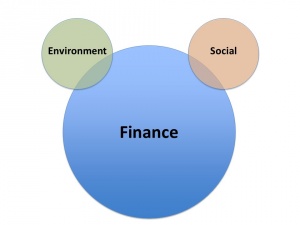The relationship between economic, social and environmental systems is usually shown in one of two ways:

In this first graphic, the three systems are shown as separate yet connected systems. The point where all three circles intersect is referred to as the sweet-spot where outcomes are sustainable, by balancing the economic, social and environmental concerns. This model is sometimes referred to as “weak sustainability”. It tends to encourage trade-offs where economic objectives take priority over environmental and social objectives.
Some people, cynically, refer to it as the “Mickey Mouse” model, with reality looking more like this second graphic.

Discussion forum activity
- Take a moment to think about the above and consider the following questions:
- Do you agree with this model?
- How might it constrain or inform decision making to encourage decision-making that supported sustainability?
- What do you think about the Mickey Mouse model?
- Do you think it reflects the current, business-as-usual mindset towards sustainable practice?
- Write your answers in the Discussion Forum. Look for the appropriate topic.
You must be logged in to post to WEnotes.
The relationship between economic, social and environmental systems is usually shown in one of two ways:
In this first graphic, the three systems are shown as separate yet connected systems. The point where all three circles intersect is referred to as the sweet-spot where outcomes are sustainable, by balancing the economic, social and environmental concerns. This model is sometimes referred to as “weak sustainability”. It tends to encourage trade-offs where economic objectives take priority over environmental and social objectives.
Some people, cynically, refer to it as the “Mickey Mouse” model, with reality looking more like this second graphic.
Discussion forum activity
You must be logged in to post to WEnotes.
Content is available under the
Creative Commons Attribution Share Alike License.
Privacy Policy | Authors